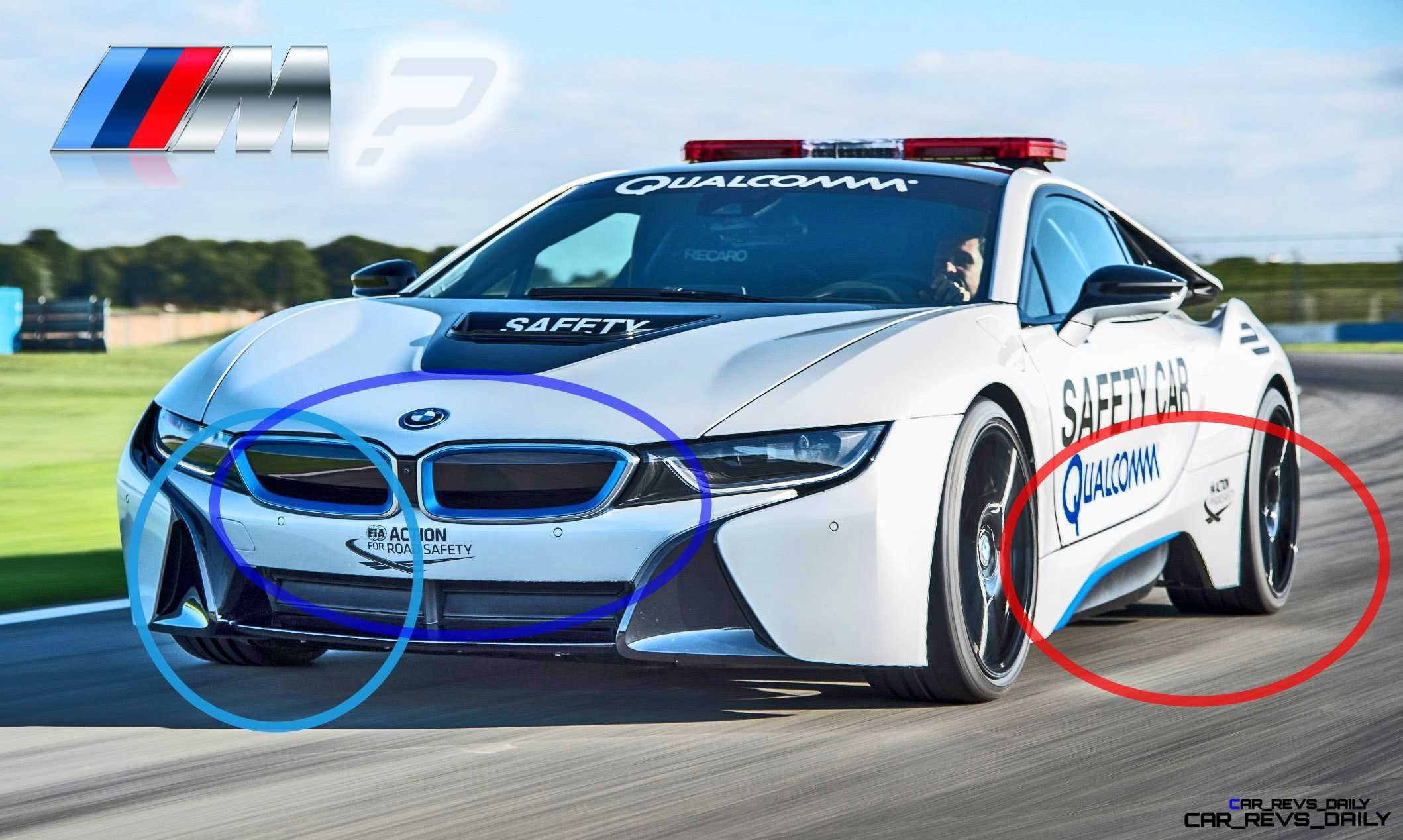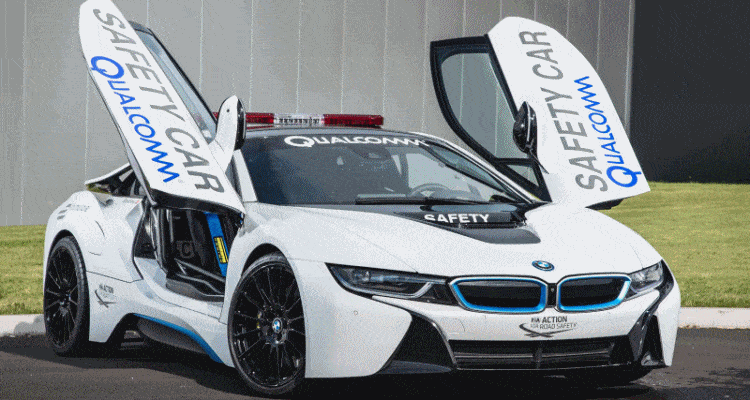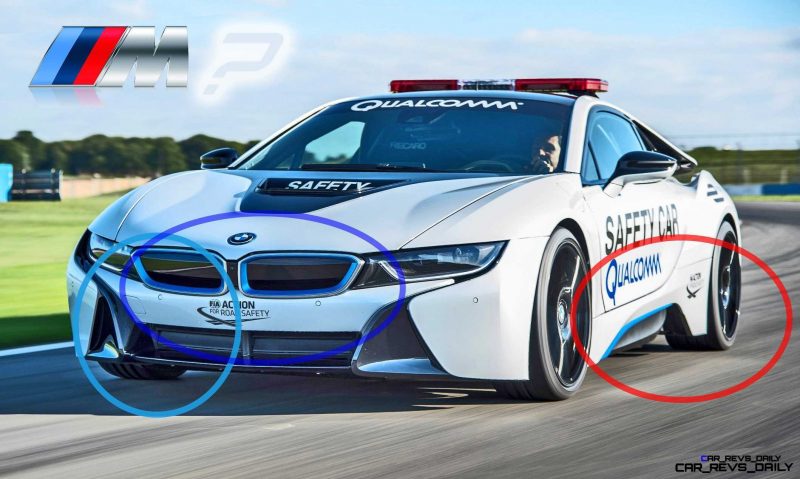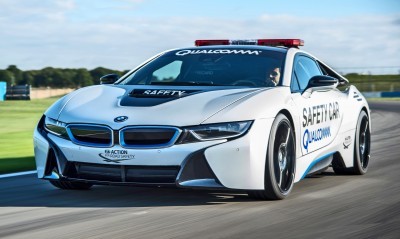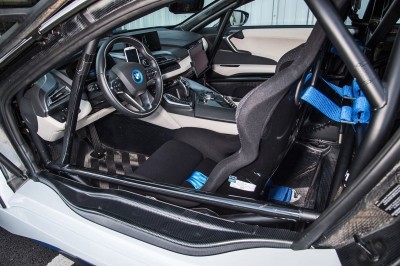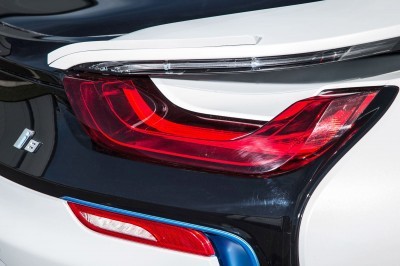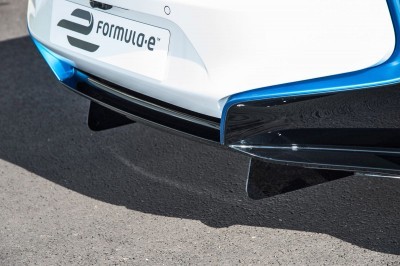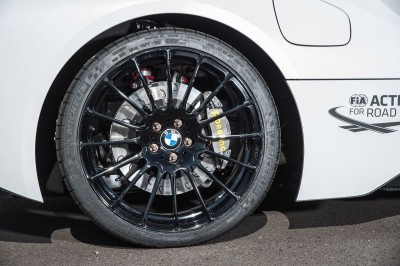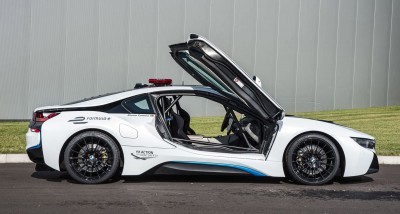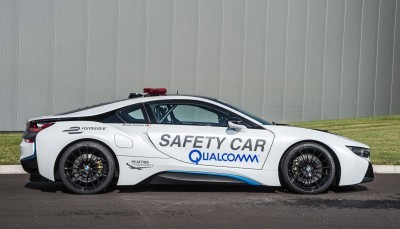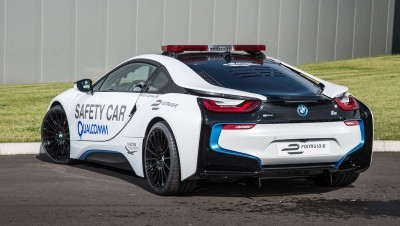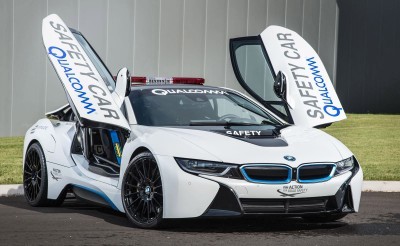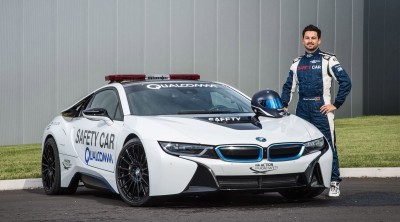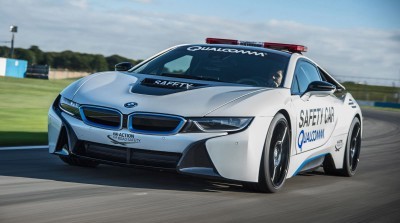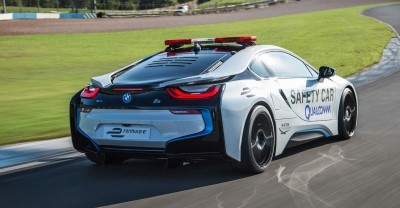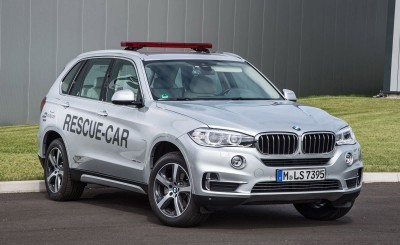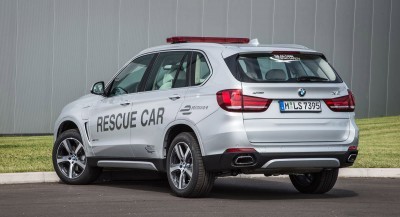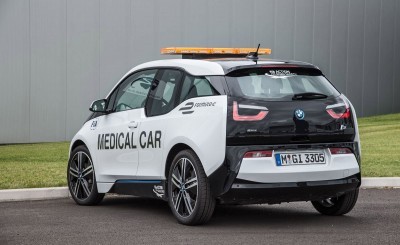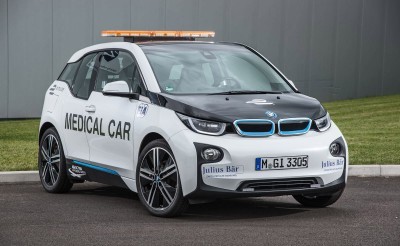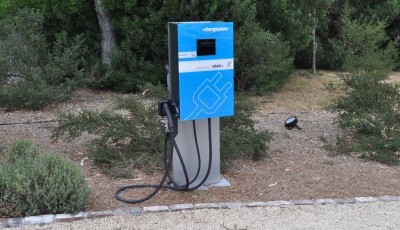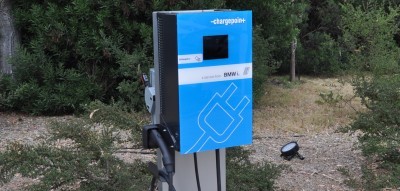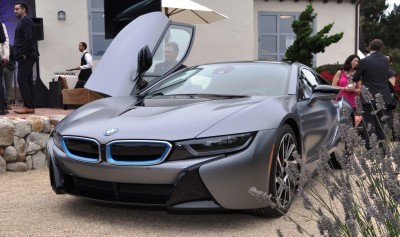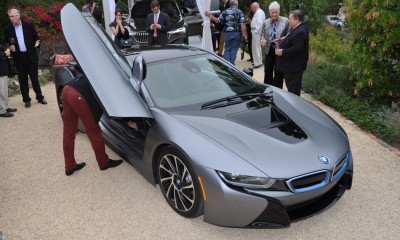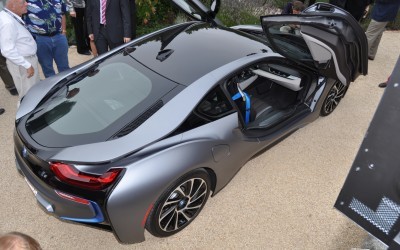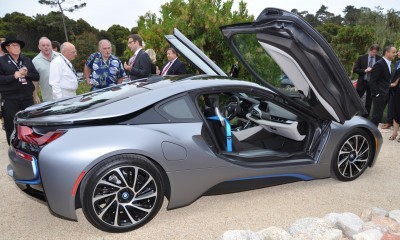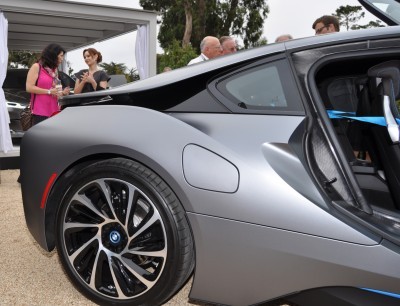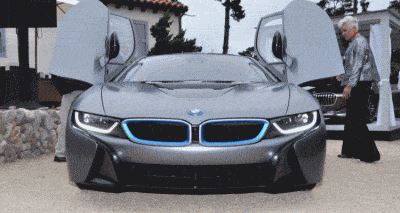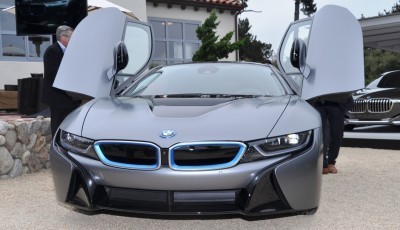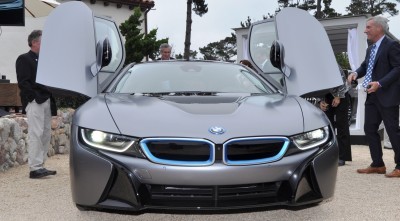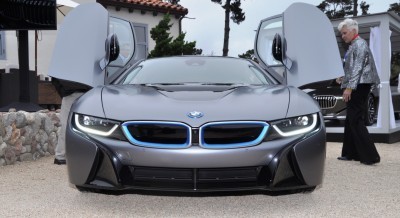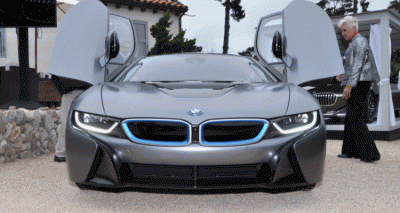 BMW has re-signed as the official safety and medical car provider for the second-ever Formula E race series! The 2015/2016 series will feature a number of electric BMW’s on track for assistance and support duties, including bikes and an X5 eDrive. The i3 will be a medical support vehicle as well.
BMW has re-signed as the official safety and medical car provider for the second-ever Formula E race series! The 2015/2016 series will feature a number of electric BMW’s on track for assistance and support duties, including bikes and an X5 eDrive. The i3 will be a medical support vehicle as well.
But the really fast laps demand a fast safety and pacecar, of course!
And here is the perfect machine, the PHEV BMW i8.
And not just any i8, either. A few interesting tidbits about this pacecar are extremely promising. Wireless charging and a huge chassis upgrade that may point to a future performance variant of the i8. Whisper it… but that might be called the M8.
— wireless charging: the i8 is the first production-vehicle application of the new Qualcomm Halo 7.2 kW inductive charging tech. This innovation is still in its infancy, and is not like beams of energy collected while the car drives. (But that is the goal, eventually.) No, this system is the first step: a high-voltage charging pad in the car’s race paddock parking spot. Park the i8 on top and initialize the system, and the i8 is fully charged in less than an hour. No plugs, no cords. Beautiful!
The challenge so far with inductive chargers is that they can’t relay much voltage, and they are sensitive to anything metallic coming between the car and the Halo charger pad. Things like coins or cans in the way trigger the system to stop and alert the owner. If there were no smart setup for the pad and metal objects were between it and the charger, there is potential to melt or ignite those cans or coins.
So still a few safety hurdles, but ones that are being hopped rapidly via the Formula E electric racers.
— i8 Pacecar has a huge list of performance mods.
Not just a roll cage and a lightbar for this track machine. The list is mostly grip, safety and aero based — but also relates to suspension and chassis structures. All this points to the safety car needing more grip and more air than the stock vehicle. It also shows what steps BMW’s M division might take for an M8.
The i8 Safety Car features a battery pack more than twice the capacity of the factory machine: ~17 kWh versus 7kWh. This alone would be enough to require the near-doubling of tire contact patches front and rear!
Technical modifications to the new BMW i8 Safety Car over the standard production car:
Chassis
-
Modified chassis mount points and upper wishbones
-
Custom-made Bilstein springs / dampers
-
15 mm lowered chassis
Wheels / tyres
-
20” ATS racing rims: black, powder-coated
(front: 245/ 35 R20, rear: 285/ 30 R20)
-
Michelin Pilot Super Sport sports tyres
Brakes
-
Motorsports brake discs and callipers (six-piston at the front, four-piston at the rear)
-
Improved ventilation / cooling for the front discs
Direct in-flow of air via the front spoiler and deflector plates
-
Modification to the rear section of the underbody (additional air intakes, spoiler) and airflow to the brake discs via supply tube and deflector plates
Aerodynamics
-
Kidney grille split at half height
Modified front-end airflow
-
850-watt fan (front)
-
Number of dynamic pressure flaps in fan shroud increased
-
Modified bonnet outlet cover and airflow
-
Modified air deflectors
-
New air deflectors and air deflector plate on the underfloor of the car
-
Rear window replaced by plastic cover with air outlets
-
Sound absorption panelling for the engine removed
-
Two additional fans in the engine compartment
-
C-pillar ventilation removed
-
Lower-mounted engine soundproofing removed
-
New anti-roll bar bearings
-
Extension of diffuser below the combustion engine (75 mm)
-
Heat insulation for the exhaust system
-
Additional carbon-fibre spoiler lips at the rear
-
Additional diffusers on the underfloor of the car (front and rear)
High-voltage battery
-
Battery cell modified for testing purposes, now has higher electric output (+ approx. 10 kW)
Modified roll cage
-
Seamlessly drawn precision pipe (25 CrMo4)
-
Yield strength: 640 Nm/mm²
-
Tensile strength: 695 Nm/mm²
-
Bolts quenched and tempered
-
Roll cage weight: 48 kilograms
-
First FIA-certified BMW i8 roll cage
New inductive prototype charging system (Qualcomm Halo™)
-
BMW i8 FIA Formula E Qualcomm Safety Car is the world’s first vehicle to offer 7.2 kW inductive charging based on Qualcomm Halo™ prototype technology
-
Tested under all extreme climatic conditions
-
EMC-approved
BMW i8 FIA Formula E Pacecar
- 25.08.2015
| BMW i8: Official FIA Formula E Qualcomm Safety Car, Season 2015/2016 | Show all media |
Donington , 25 August 2015. BMW will be lining up for the FIA Formula E Championship once again in 2015/16 . The second season of the race series gets underway in Beijing on 17 October 2015, and BMW will be on hand as the Official Vehicle Partner.
The futuristic BMW i8 sports car (fuel consumption combined: 2.1 l/100 km / 134.5 mpg imp; CO2 emissions combined: 49 g/km) will once again see action as the Safety Car in the trailblazing race series for electrically-powered formula machines. And the all-electric (and therefore emission-free) BMW i3 (energy consumption combined: 12.9 kWh; CO2 emissions combined: 0 g/km) will perform the role of Medical Car, as it did in the series’ inaugural season. Added to which, a pair of BMW C evolution electric scooters and a BMW X5 xDrive40e plug-in hybrid (fuel consumption combined: 3.4–3.3 l/100 km / 83.1–85.6 mpg imp; CO2 emissions combined: 78–77 g/km; figures based on the EU test cycle, may vary depending on the tyre format specified) will be making their Formula E debuts, as models from other BMW Group brands join the BMW i cars in the eDrive family .
“BMW i and Formula E make a great match,” said Jörg Reimann, Vice President BMW Brand Experience. “The world governing body of motor sport, the FIA, is branching out in a new and extremely interesting direction with the FIA Formula E Championship – and we have been on board from the outset. The series got off to a highly successful start in its first year on the calendar, with its all-electric formula racing cars, tight street circuits running through the heart of major world cities and innovative ideas engaging fans via social networks. BMW has been involved in Formula E from the word go. It signed up as the Official Vehicle Partner to supply the BMW i8 Safety Car and BMW i3 Medical Car. And this commitment has given the company a platform on which to press its claim as a leader in electric mobility. We’ve succeeded in bringing the driving pleasure for which BMW is renowned to the attention of millions of people in major cities around the world. The ball is very much rolling now; in 2014 and 2015 we laid the foundations for a successful partnership, and it’s one which will continue into the second season of the championship in 2015/2016.”
Formula E will become an “open” championship in its second season. Compared with the inaugural edition of the series, in which all the cars were technically identical, eight of the ten teams will line up for the new season with their own technology. The technical changes will be concentrated on the powertrain – specifically the electric motor, the inverter, the transmission and the cooling system – and see the cars differing in terms of speeds, soundtrack and, above all, efficiency levels over the race distance.
The 2014/15 Formula E calendar featured eleven races in ten countrieson three continents. Ten teams took their places on the grid for that opening season, each with two drivers at the wheel of standardised cars. Nelson Piquet Jr. wrapped up the title in the final race in London – and duly took his place in the history books as the first ever champion in this new series.
The new season will begin on 17 October 2015 and again take in eleven races in ten countries.
For further information on FIA Formula E go to: www.fiaformulae.com
The 2015/2016 season: Official FIA Formula E Vehicle Partner extends its line-up of models featuring new BMW eDrive technology.
The eDrive technology introduced through BMW i since 2013 will be carried over gradually into models from the core BMW brand. It will be included in the following vehicles as part of the Formula E race series.
BMW C evolution.
BMW Motorrad is supplying the FIA Formula E organisation with two BMW C evolution electric scooters for use as shuttles. The scooters enable zero-emission riding:
- Range in everyday use on battery-electric power only (EU):
100 kilometres (62 miles) - Maximum output: 35 kW (47.5 hp)
- Maximum torque: 72 Nm (53 lb-ft)
- Top speed: 120 km/h / 75 mph (electronically governed)
- 0 – 100 km/h (62 mph): 6.2 seconds; 0 – 50 km/h (31 mph): 2.7 seconds
- Innovations: reverse assist, Torque Control Assist, four riding modes, ABS, hybrid chassis, TFT colour display, LED daytime running light and sidelight, electrical safety to passenger car standard.
BMW X5 xDrive40e.
Available from autumn 2015, the BMW X5 xDrive40e plug-in hybrid will be deployed as the Official FIA Formula E Rescue Car over the course of the new Formula E season and has been adapted to the technical requirements of the FIA.
- Range on electric power only (EU): up to 31 kilometres (19 miles)
- Overall range: over 800 kilometres (497 miles)
- System output: 313 hp
- Maximum system torque: 450 Nm (332 lb-ft)
- Top speed: 210 km/h / 130 mph (120 km/h / 75 mph on electric power only)
- 0 – 100 km/h (62 mph): 6.8 seconds
Modifications to comply with FIA Formula E requirements:
- Bank of LED lights and stroboscope light
- FIA radio equipment and transponder integrated into the vehicle electronics
BMW i3.
The battery-electric BMW i3 will continue as the Official FIA Formula E Medical Car. Two BMW i3 cars will be supplied for the electric race series:
- Range on electric power only (EU): up to 160 kilometres (100 miles)
- Maximum output: 170 hp
- Maximum torque: 250 Nm (184 lb-ft)
- Top speed: 150 km/h / 93 mph (governed)
- 0 – 100 km/h (62 mph): 7.2 seconds
Modifications to comply with FIA Formula E requirements:
- Bank of LED lights, fire extinguisher, paintwork and decals
- FIA radio equipment and transponder integrated into the vehicle electronics
- Attachment points for medical equipment
BMW i8.
The BMW i8 is the most progressive sports car of our times and, by combining the performance and appeal of a sports car with small car fuel economy, created a new segment as the first sustainable sports car. It offers zero-emission driving in town (eDrive) and efficient sports car performance out of town, where a highly turbocharged and efficient 1.5-litre petrol engine with BMW TwinPower Turbo technology also comes into play.
With its revolutionary vehicle concept – which brings together a carbon-fibre passenger cell, aluminium chassis and benchmark aerodynamics for its segment (Cd: 0.26) – the BMW i8 represents the company’s technological cutting edge.
The BMW i8 will continue as the Official FIA Formula E Qualcomm Safety Car through the second season of Formula E. The modifications to the two new Safety Cars are far more performance-oriented and they have been adapted to meet the FIA’s technical regulations ahead of the new season, which gets underway in Beijing on 17 October.
The new BMW i8 Safety Car is the world’s first vehicle equipped for inductive charging with 7.2 kilowatts of power using Qualcomm Halo™ prototype technology. This allows the high-voltage battery of the BMW i8 to be fully recharged in around one hour only.
- Range on electric power only (EU): up to 37 kilometres (23 miles)
- Overall range: over 600 kilometres (373 miles)
- System output of FIA Formula E Safety Car: approx. 380 hp
- Maximum system torque: > 570 Nm (420 lb-ft)
- Top speed: 250 km/h / 155 mph (using electric power only: 120 km/h / 75 mph)
- 0 – 100 km/h (62 mph): < 4.4 seconds; 80 – 120 km/h (50 – 75 mph): 2.6 seconds
Modifications to comply with FIA Formula E requirements:
- Certified safety cell – bolted and bonded to load-bearing elements of the body. Use of patented tube joints.
- New bank of LED lights and stroboscope light
- FIA radio equipment and transponder integrated into the vehicle electronics
- 2 x additional 12V sockets with 25A fuse
- Carbon-fibre racing seats
- Carbon-fibre centre console
- Six-point safety belt
- Removal of interior trim and airbags
- Modified trim elements on safety cell
- Modified position of safety belts
- Official decals

Tom Burkart is the founder and managing editor of Car-Revs-Daily.com, an innovative and rapidly-expanding automotive news magazine.
He holds a Journalism JBA degree from the University of Wisconsin – Madison. Tom currently resides in Charleston, South Carolina with his two amazing dogs, Drake and Tank.
Mr. Burkart is available for all questions and concerns by email Tom(at)car-revs-daily.com.

